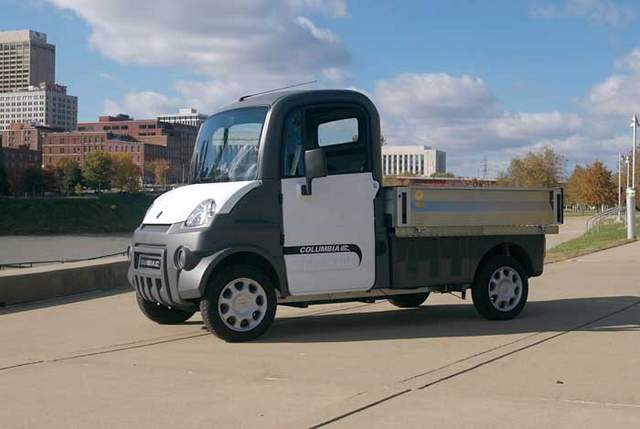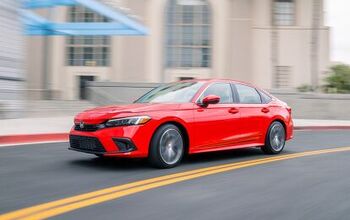Could The American Military Fund An Advance In Electric Cars? Should They?

Behold! The American military electric vehicle! Also known as the Columbia ParCar, it’s part of a broad-based Department of Defense program to purchase off-the-shelf NEVs and electric cars for non-tactical use. Seems like a very reasonable idea; in case of war, gasoline might be required for other things like fighter jets and napalm.
After reading some details of Zero Motorcycles’ 2013 range of two-wheeled electric vehicles, however, I’m wondering if there isn’t more that infamous military-industrial complex could be doing to make the next generation of Nissan-Leaf-a-likes more useful.
Zero Motorcyles’ latest press release regarding the Zero MMX mil-spec two-wheeler notes that
“It was a very rewarding experience for the Zero team to go through such an exacting development process. The military needed a very specific set of core features on the MMX, and we were incredibly thankful to work side-by-side with them to deliver such a unique product,” said Abe Askenazi, Chief Technology Officer for Zero Motorcycles. “The great news for our civilian customers is that we made the decision to incorporate into our 2013 MX, FX and XU retail motorcycles virtually all of the powertrain enhancements associated with satisfying this project’s stringent military requirements. Our 2013 product is truly ‘military grade’!”
No doubt this press release is no more connected to actual reality than, say, any given sack of alphabetic vomit from Bentley that talks about the Mulsanne’s “upscale appeal” but fails to mention that it looks like the kind of fish you’d find five miles beneath the surface of the ocean, but it leads to what might sound like an odd or awkward question to be asking in 2013: Why isn’t the military taking an active role in the development of advanced electric cars? After all, NASA might have brought us everything from TANG to the transistor radio with a helping of Omega Speedmaster on the side, but the agency’s fallen on hard times due to the average American’s inability to get too excited about space flight while working two McJobs during the day and performing amateur oral surgery on the neighbors in the evenings.
The US military, on the other hand, seemingly never runs out of places to invade and/or advise. Couldn’t some of that be done with electric vehicles? In the relatively short space of four years in WWII, the parties involved went from the Brewster Buffalo to the Messerschmitt 262. Once the war was over, all anybody could manage was a Messerschmitt KR200. Obviously, war is an excellent stimulus to R&D.
One of the qualities that worries potential purchasers of the Zero Motorcycles more than almost any other — the bike’s eerie silence — is actually an advantage in a military context. By the same token, perhaps the painfully inoffensive shape of modern hybrids could be used to lull our enemies into complacency. Think of it. One minute the so-called “insurgents” are laughing at a Prius with a “Coexist” sticker making its way up a mountain pass, the next minute they’re meeting the deities of their choice courtesy of a fifty-caliber round to the dome. Or we could use specially-prepared Tesla roadsters that are designed to catch fire in a riff on the old “Divine Wind” program.
The possibilities are endless… but if involvement with the military made the 2013 crop of Zero Motorcycles better, why hasn’t GM asked soldiers to drive the Volt? Oh, that’s right…
…the Geneva Convention.

More by Jack Baruth
Latest Car Reviews
Read moreLatest Product Reviews
Read moreRecent Comments
- ToolGuy 9 miles a day for 20 years. You didn't drive it, why should I? 😉
- Brian Uchida Laguna Seca, corkscrew, (drying track off in rental car prior to Superbike test session), at speed - turn 9 big Willow Springs racing a motorcycle,- at greater speed (but riding shotgun) - The Carrousel at Sears Point in a 1981 PA9 Osella 2 litre FIA racer with Eddie Lawson at the wheel! (apologies for not being brief!)
- Mister It wasn't helped any by the horrible fuel economy for what it was... something like 22mpg city, iirc.
- Lorenzo I shop for all-season tires that have good wet and dry pavement grip and use them year-round. Nothing works on black ice, and I stopped driving in snow long ago - I'll wait until the streets and highways are plowed, when all-seasons are good enough. After all, I don't live in Canada or deep in the snow zone.
- FormerFF I’m in Atlanta. The summers go on in April and come off in October. I have a Cayman that stays on summer tires year round and gets driven on winter days when the temperature gets above 45 F and it’s dry, which is usually at least once a week.

































Comments
Join the conversation
Money isn't spent by the military for general science R&D - only for projects that contribute to a military mission. If there are civilian applications down the road that's a fringe benefit. Behind the lines they're already using electric utility vehicles for tasks around the base, not much to R&D there, but there is serious work being done developing hybrid drives for Humvees and larger tactical vehicles. The military is virtually gasoline-free, everything now runs on either diesel or jet fuel, often interchangeably.
Quantum CERV. It exists, and is documented on YouTube. I don't recall if it or another similar one was utilizing four wheel motors.